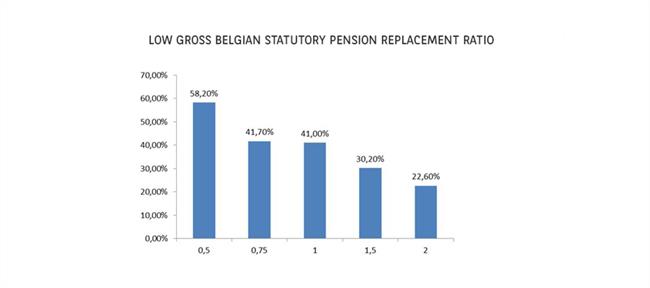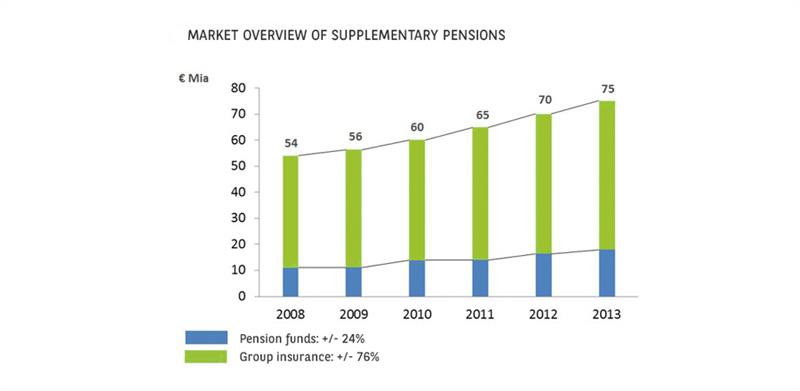The vast majority of company pension plans are of the group insurance type. An alternative are the pension funds. Is your company eligible?

In Belgium, group insurance is by far the most popular way of setting up a company pension scheme. According to Assuralia, approximately 95% of employers outsource the second pillar to an insurer. In some cases, a pension fund is nevertheless a viable alternative. In Belgium, there are approximately 200 pension funds – good for 1% of the employers and more than 1 million active participants. In terms of technical commissions, they take up about 24% of the market. The sectorial plans in the construction, metal and non-profit sectors are, for example, pension funds. What is the difference with insurance? And who is eligible?
- An insurance plan has advantages. You outsource it and it requires no further attention on your part. The insurer also guarantees a certain return. But there are also disadvantages. The guaranteed return is currently very low and will probably remain so for a while. And there is not much you can do, because it is the insurer who decides on the allocation. The insurer is also obliged to invest conservatively. An insurance plan has to comply with strict rules, such as a guaranteed minimum annual return. Finally, you have to be satisfied with one party who arranges all aspects of the service.
- A pension fund operates differently. The company (or the sector) establishes an OFP, an organism for the financing of pensions. This allows it to be free and flexible when making decisions about all aspects of the company pension scheme: who will take care of the administration, who will be the actuary and who will be managing it. You also decide on the allocation. An OFP is not aiming for a fixed yearly return, but for an average return over the long term. In this way, you can define a risk profile with which you feel comfortable, consisting of an appropriate mix of bonds, equities, etc., in the hope of achieving a higher return. It is up to the asset manager to guide the organisation and to find a good balance between risk and return. To have a pension fund, your organisation has to be of a certain size and scale. A significant part of the annual costs are the fixed costs for the actuary and administration, and partially fixed costs for the management by the asset manager. This can remain reasonable in proportion to the size of the pension fund.
The message is: dare to compare the two options. An insurance plan is not set in stone. If you decide to change to a pension fund, the insurance can be phased out or you can transfer the amount to the fund. The important thing is to review the existing contract and possible costs, and to properly negotiate with your insurer.
Insurance plan vs. pension fund
Insurance plan
- Guaranteed minimum annual return
- The insurer is obliged to invest conservatively
- Ease of use of an all-in-one solution
- Also an option for small organisations
Pension fund
- No guarantees, but a real chance of a higher return
- Investment strategy and risk level to be determined in consultation
- Requires active participation of the organisation (OFP)
- A certain size and scale is required to bear the annual charges
27.06.2016
The first pension pillar: some improvements, yet still problematic
The Pension Committee's points system is more transparent and restores the link between length of service and the statutory pension. But it does not solve the problem of its affordability.
If you received one euro for every sentence which has the words 'pension' and 'problem' in it, you would soon be very rich. And no longer troubled by the pension problem. Shame. The statutory pension – the 'first pillar' of the pension system – is giving Belgium a collective headache. The problem is well-known: due to the ageing population there are increasingly fewer working people and increasingly more pensioners, who are also living longer. The recession is the icing on the cake: the government debt is rising and tax revenue is falling. This mix of factors is causing a 'perfect storm' in our distribution system – in which the working people are paying for the current pensions.
The points of the Pension Committee
Avoiding the storm? A pension system is like a tanker which can only be forced into a new direction little by little. The Pension Committee, set up by outgoing Minister of Pensions Alexander De Croo, tried to do so by drawing up a Pensions Report and proposing a new pensions system. What are the key aspects?
- Working longer yields a higher pension, and that pension is calculated on the basis of a points system. For each year that you earn as much as other employees, officials or self-employed persons earn on average in one year, you receive one whole pension point. If you earn less or do not work full-time, you receive less. If you work or earn more, you receive more. One point corresponds to a specific pension amount. The points system would allow for variations, for instance for heavy and arduous professions, and periods of sickness or unemployment. Everyone must be able to see, year on year, how many points they have accumulated.
- The career length is also undergoing changes: if you want to take early retirement, you must have worked 42 years. Part-time retirement and part-time work is also an option. A notable point: the three regimes (employees, officials and self-employed) continue to exist but are gradually converging.
Peter De Keyzer (Chief Economist at BNP Paribas Fortis) has praise for various ideas:
“The points system restores the link between length of service and the pension amount. The system is also more transparent: you can see how many points you have accumulated. Given that the points system will be introduced for the three regimes, they will be better comparable and can gradually converge. I also see some drawbacks. For example, the report is too non-committal about the link between the retirement age and life expectancy. In 20 years, we will, on average, live 6 years longer.”
Further reforms necessary
In the meantime, the new government is preparing a pensions reform. A few measures have already been made known. The retirement age has been increased to 67 years of age. The rest is still unclear. If the government retains the proposed points system, it will have to decide how much a pension point is worth. But we should not expect any miracles. The statutory pension will not suddenly make us rich. On the contrary. The replacement ratio (the pension expressed as a percentage of the last salary) is not high at the moment and will probably stay that way. In this respect, Belgium is one of the failures in the western world, as this graph shows:
(Source: OECD – Pensions at a glance (2013))
Pension contributions are no longer capped (the more you earn, the more you contribute), but the statutory pension is: how ever much you contribute, you will never get above a certain ceiling. The impact of this is most noticeable for those with higher incomes. For employees with an average salary (EUR 46,100), the replacement ratio of the statutory pension is 41%. When you earn double this amount, it is less than 23%. This graph shows a few figures:
(Source: OECD – Pensions at a glance (2013))
27.06.2016
The second pension pillar: what about the guaranteed minimum return?
Due to the low interest rates, it is uncertain whether insurers will achieve the mandatory minimum return. Unfortunately it is not the insurer, but you, as an employer, who is responsible for this guarantee. Will it be reduced?

The second pillar, the supplementary pension acquired through professional activities, is for your employees the main way to bridge the gap between their statutory pension and the pension amount they wish to receive. The system is well-known. You pay a percentage of your employees' gross salary into a pension pot (employer's contributions). In a number of cases they also contribute a percentage (personal contributions). Usually this is a group insurance, sometimes a pension fund.
The invested capital becomes available when the employee turns sixty, but for tax purposes it is more interesting not to collect it before the 62nd birthday. The vast majority of people opt for payment in the form of capital: they receive a one-off amount. The rest opt for the system of a lifelong annuity and receive a monthly income for the rest of their lives. As a rule of thumb: for each EUR 100,000 in accrued capital, you receive approximately EUR 500 per month.
Rising degree of coverage
Are you already providing a second pillar at your company? If so, then you are not the only one. Pension plans for companies are in the meantime widespread... but are certainly not yet found everywhere. The commissions are growing steadily by billions of euros, on average by almost 7% a year:
(Source: Assuralia & FSMA)
But many Belgian employees currently still have no access to the system. Benoit Halbart, Director Marketing & Communication AG Employee Benefits - Health Care, says:
“The degree of coverage is rising, from 35% in 1999 to 75% in 2013. This is mainly due to the success of the sectorial plans. Through these sectorial plans, employees in small companies are catching up with manual workers and executives. Some sectors and profession groups are lagging behind: the interim sector, the distribution sector and the joint committee 200, the supplementary national joint committee for employees. It's high time that all companies establish a second pillar.”
The second problem is the sometimes very low premiums. In the sectorial plans, for 51% of the employees only 1% to 1.75% of their salary goes towards the pension scheme. For 48%, it is even less than 1%. Far too little, says Benoit Halbart:
“A contribution of 3% is a first step, but not enough. The additional replacement ratio is then about 6%.”
In its policy statement, the Michel I government states that salary increases can be partly used to increase the contribution level to at least 3%. It asked the social partners to negotiate this percentage. In addition, your employees will be able to take the initiative to voluntarily accrue a supplementary pension in the second pillar, which will be financed by salary deductions. The employee can determine the amount, within certain limits, and the deductions enjoy the same tax benefits as the personal contributions in a traditional pension scheme. A good idea, says Benoit Halbart:
“In most sectorial plans there is still no sign of personal contributions. In the other pension plans, 60% of middle management and employees and 40% of manual workers pay mandatory personal contributions.”
WAP guarantee
The WAP guarantee ('Wet op de Aanvullende Pensioenen', Act concerning Supplementary Pensions) on minimum returns is a hot topic in the second pillar. It is employers, rather than insurers or fund managers, who are responsible for guaranteeing this minimum return at the end of the line. This is a unique arrangement which does not exist anywhere else in the world.
Until recently, the WAP guarantee amounted to 3.25% of employer's contributions and 3.75% of personal contributions. However, in mid-October 2015 the social partners concluded an agreement to amend the guarantee. Beginning on 1 January 2016, the system will become a variable one, where the guaranteed annual annuity will amount to a given percentage of the average return on 10-year government bonds, calculated over a period of 24 months. The resulting figure cannot in any case be lower than 1.75%, nor can it exceed 3.75%. Benoit Halbart:
"So far, the WAP guarantee has not given rise to any problems. Due to the low interest rates, we at AG Insurance reduced our guaranteed return for new contributions to 1.5%, but through the profit-sharing scheme our customers are assured of a return of 3.25% on all contracts until 2016.
If interest rates remain low, problems may arise for employers in the long term. Employers may then have to make additional deposits when an employee retires. This may inhibit the willingness of employers to further extend the second pillar."
25.04.2016
The third pension pillar: peace of mind or greater return?
In the third pillar your employees face a dilemma. Do they choose the peace of mind of pension savings insurance or the chance of greater returns from a pension savings fund?
As it is so interesting from a fiscal point of view, you probably also participate in pensions savings in the third pillar. Good to know: the government has frozen the maximum permitted savings amount at EUR 940 per year until 2018. Other tax rules have also recently been amended:
- The final tax on the accumulated capital drops from 10% to 8%.
- However, that final tax will be collected earlier. Until now it was levied on the 60th birthday. This was a tax in full discharge: the deposits made between the 60th and 65th birthday were no longer taxed. In the new system, 1% is deducted each year from 2015 to 2019, calculated over the value of the savings on 31 December 2014. That is therefore 5% in total. This deduction is an advance on the final tax. On your 60th birthday you will pay the final tax of 8%, less the deducted collections for the years 2015 to 2019. In short: 3%.
Still, the third pillar (individual savings with a tax benefit) remains a no-brainer. Even with the lower interest rates, the return is better than a savings account and the tax benefit is still 30%. Less black-and-white is the choice between a pension savings insurance and a pension savings fund. What do you recommend to your employees?
Risk-return ratio
Pension savings insurance offers a capital guarantee and a minimum return. It is a risk-free formula. A pension savings fund is an investment fund managed by a bank or brokerage firm. They invest your money in a variety of equities and bonds. Neither the capital nor the return are guaranteed. But in the long term, you can usually expect a higher return.
There is one piece of advice you can give your employees on their first day: start saving for your pension as early as possible. Eric Vanbrusselen (General Manager Business Development Life Insurance with AG Insurance) says:
“The traditional strategy in the third pillar is to start young! If you choose savings insurance, you take advantage of the effect of the combined interest rate. The longer you save, the more pronounced the snowball effect is. If you choose a savings fund, the long term may ensure that shocks on the stock exchange are evened out.”
The choice between savings insurance and a savings fund is not as black-and-white as it sometimes seems. There are, for instance, risk-graded formulas in savings funds, which vary between dynamic (with, for example, 70% equities and 30% bonds), neutral (50-50) and conservative (30-70).
Bart Van Poucke (BNP Paribas Investment Partners) says: “The choice depends on your risk profile and your age. Young people, who like the idea, can allow themselves to take a little more risk. If investors are confronted with a crisis such as that seen in 2008, then there is still time to recoup the losses.
After your 40th birthday you must start to watch it all a bit more closely. If you have had a few good years with a dynamic savings fund, you can consider changing to a more defensive savings fund or savings insurance. In this way you avoid losses due to difficulties on the stock markets just before you retire. If this is still the case, nothing will stop you leaving the money where it is until the losses have been recouped. This, of course, on the assumption that you do not need the money at the time.”
The ratio between new pension savings insurance policies and pension savings funds is currently about fifty-fifty: savings insurance has risen during the last few years at the expense of savings funds. Despite the low interest rates given by insurers (approximately 1.5%), more Belgians currently choose the peace of mind of pension savings insurance, with the crises of 2008 and 2011 apparently still fresh in their minds. Let's wait and see what the future holds.
Best pension savings fund in Belgium
BNP Paribas Investment Partners has been given the ‘Best Pension Savings Fund in Belgium’ award by De Tijd and L’Echo for the third year in a row. Bart Van Poucke manages these funds together with his team at BNP Paribas Investment Partners. How is he able to make a difference in a market in which strict legal investment restrictions apply? Here he discusses three tricks of the trade:
- “In the shares section, managers have been allowed to invest in equities in the entire European Economic Area since 2004. We still deliberately opt to maintain a large amount of Belgian equities. On average, they have fared better.
- We are legally obliged to invest a certain number of the equities in small caps and micro caps, equities of smaller companies. This market is more difficult to gauge than that of the very large enterprises, the so-called large caps. Specifically in this section, our specialists make the difference: they know these 'smaller' companies very well and are able to gauge which equities will give the best return. Their choices have often worked out well.
- Also in terms of bonds we have made different choices. Just like everyone else, we sold our interests in Greek bonds when the problems started in 2011, but we maintained our positions in the Spanish and Italian government bonds, despite the fact that they were under great pressure at the height of the debt crisis in 2011. When the pressure died down, the interest rates started to fall and fell stronger than those in the core countries. We used this to our advantage to generate greater returns.”
09.12.2024
Managing business uncertainty with BNP Paribas Fortis
Every entrepreneur will tell you that financial markets are unpredictable, entailing inherent risks. We provide tailored solutions to protect your business as you navigate these volatile markets.

Whether you’re a small or large business, operating domestically or internationally, one thing is certain: if you enter a market and do your utmost to grow your business, sooner or later there inevitably will come a time when you expose yourself to risks. Frédéric Raxhon, Head of FI Midcap Sales, BNP Paribas Fortis Transaction Banking, is our go-to expert. Here, he explains how BNP Paribas Fortis helps customers manage this uncertainty.
Raxhon knows how market volatility can impact the daily operations of small, medium and large enterprises. Thanks to his experience of working as a banker in corporate finance, shares and derivatives, and advising holding and listed companies, he understands how the market works like no other.
Raxhon: "We are keenly aware that price uncertainty, in the form of volatility on the financial markets, can have a serious impact on the operations and profitability of businesses. That’s why we constantly monitor the markets and their volatility: if prices fluctuate sharply, our customers run the risk of buying high and selling low. The past few years are a good example of what can happen, with a sudden rise in interest rates, an energy crisis with very volatile prices, and a sharp rise in inflation. We will continue to see volatility in these markets, due to geopolitical tensions and ongoing wars. However, elections can also cause volatility, as they often cause a change in economic policy. President-elect Donald Trump has already said that he will hike tariffs on goods coming from outside the U.S., which will have an impact on global growth and inflation. The transition to a more sustainable society because of the energy transition, however positive this may be, is also a source of uncertainty. Companies will be required to make significant investments, and it is not yet clear which technologies will prevail.
All of these factors show that companies need guidance in the form of a tailor-made solution to ensure that volatile markets minimise the impact on their operations so that they can focus on their core business."
Solution-oriented
The solution to this volatility comes from a partner who is a market leader when it comes to safeguarding national and international business.
Raxhon: "At BNP Paribas Fortis, this often means managing the risks of companies that have a number of straightforward wishes: they want to conduct business on a daily basis without unnecessary complications; buy at a stable price where possible; pay wages in a stable environment; sell to customers with a profitable, stable margin, and so on. If they experience market uncertainty in their business operations, we are there to advise them and suggest solutions in different scenarios. This can range from companies that want stability when buying or selling goods in another currency, to controlling fluctuating interest rates on current or future loans, or even creating a stable financial environment in which they can steadily pay their wages. We also hedge raw materials: companies that require large quantities of energy, metal, or wheat, for example – just a few of the commodities that are subject to price fluctuations – can rely on our expertise to turn their uncertainty into certainty. When companies are calculating their budgets for the coming years at the end of the year, assumptions about budgets and costs are a factor that future markets do not take into account. This, in turn, could lead to inconsistencies in business operations during the next financial year. We regularly suggest solutions for this, which inject trust into the entire process. We help entrepreneurs make their business more resilient to market fluctuations. Because at BNP Paribas Fortis, we are always focused on finding solutions, in any given scenario."
International intelligence
Belgian companies are increasingly expanding their horizons, which is why an international perspective is so crucial.
Raxhon: "Everything is intricately connected in the economic space. The energy crisis, for example, was not a national crisis. In Belgium, electricity prices were directly impacted by the drop in nuclear power production in France in 2022. The American elections have a direct impact on international business, with anxiety gripping investors and the markets. And I can give you many more examples.
Moreover, we expect this interdependence and volatility to continue for quite some time: there are a large number of economic and global trends that are feeding this uncertainty. And that is why it is so important that we keep up with developments in this uncertain global environment. At BNP Paribas Fortis, we rely on a global network of experts who are always on the lookout for the latest updates. Whatever happens and wherever it happens, there are always people from our bank on the ground who monitor the situation and provide us with real-time advice on how best to inform our customers. This network has proven its worth time and again, both for us and our customers."
